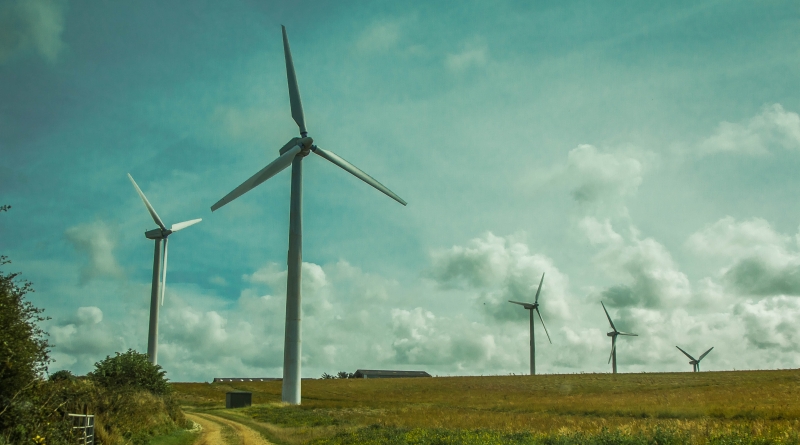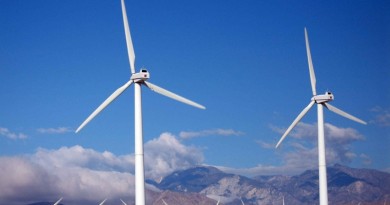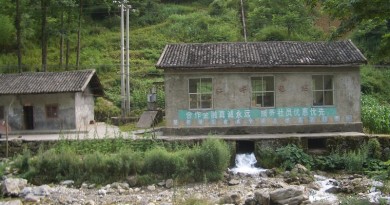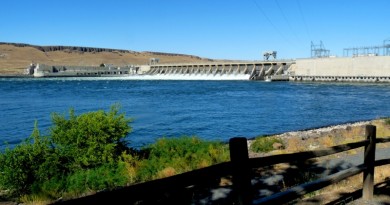Wind energy: Europe – USA comparison
Contents
Energy issues, especially about renewable energy sources have become vital because not only of the terrible environmental conditions and growing oil prices but also because of the ever-increasing need for energy. This trend is forcing the world to search for an ecologically and economically acceptable alternative to traditionally dominant fossil fuels. While there is still fossil fuels dominance, things are starting to look better as many countries acknowledged the problem of fossil fuels and focused their prime attention on renewable energy sources. One of the most promising energy source is definitely wind energy which use wind to generate electricity. Wind energy sector is becoming one of the fastest growing renewable energy sector, not only in Europe and USA, but worldwide also. Wind energy research projects are fast growing as scientists look for better solutions to maximize efficiency of wind energy and many governments invest large funds in these researches as they have started looking for long-term benefits that this renewable energy source offers.
Wind power use has very long history, but modern age started in late 70s and 80s, and in the USA first power stations were built in California. After that wind industry had constant growth for some 20 years, and today this renewable energy segment has growth of 20 to 30 percent per year worldwide, and experts predict even bigger growth in years to come, especially considering large investments that many governments plan to make. Wind energy sector significantly owns its growth to the fact that is the most economical renewable energy source (excluding hydropower), and this is the result of many researches that found ways to cut the costs of wind energy. In the 1980’s wind was costing almost ten times more than it costs now, about 40 cents per kilowatt hour, compared to the current price of about 4 to 6 cents. This reduction in costs has given wind energy sector completely new dimension and made it economically acceptable and what is an even more important – competitive to traditional fossil fuels technology. This competitiveness should really make way for other renewable energy sources as wind energy example clearly showed how big impact can be once there are long-term researches supported with large funds.
Wind energy is produced in most cases by gigantic three-bladed wind turbines located on top of tall towers on reverse principle of ventilators as they unlike ventilators use wind to make electricity and not the other way around. The working principle is this: wind turns the blades that are then starting to spin a shaft connected to a generator and this spinning produces electricity. Large turbines, used mostly for industries can generate from 750 kilowatts to even above 1.5 megawatts, while household use usually includes small turbines capable of producing only up to 50 kilowatts. Besides these three-bladed wind turbines, there are also two-bladed wind turbines in use (though more rarely) and the difference between these two turbines is that three-bladed turbines have upwind operational procedure, and the two-bladed wind turbines have downwind operational procedure. Last two decades were really a turning point in wind energy use as there was tremendous development in technology as the natural result of many different researches. Modest turbines of the eighties for instance had diameter of the rotor much smaller than today’s turbines have, only 20 meters compared to today’s 100 meters or even more. Just for comparison football field is about 100 meters long.
NEW TECHNOLOGIES AND SWERA PROJECT
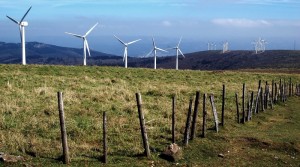
There are also new technologies developing that include projects of wind farms. Wind farm is group of wind turbines joined together in one gigantic wind power station and efficiency of these newly built wind power stations is improving almost as we speak. However there is still one large problem and this is the right location for wind farms since ideal place demands areas with strong and what is even more important permanent winds. Each specific location requires thorough research of annual wind speed to calculate the amount of energy available in winds that blow on these locations. This is the reason why developers use thorough researches before investing in certain wind farm project and for this they need to work with meteorologists in order to create certain meteorological models which are later used to calculate the efficiency of possible project and to answer the question is this project economically acceptable or not on given location. There are classes of wind power that determine the potential of certain place for possible development of wind farm. Only Wind power Class 3 areas or higher are acceptable for construction of wind farms and Wind power Class 2 areas can only be used for building smaller windmills usually for households.
United Nations are also included in this project with their SWERA project (Solar Wind and Energy Resource Assessment) that is oriented in locating suitable areas for exploiting the wind energy and to create map of possible wind and solar energy sources in 13 developing countries of the world. This project already located some suitable areas with potential of couple of thousands megawatts in Africa, Asia and Latin America. This project is also in accordance with the United Nations Environment program which is very significant from the ecological point of view. Among the most potential areas is African state Ghana that was found to have above 2,000 megawatts of wind energy potential and this is mainly near its border with neighboring Togo. There were also actions in many other countries such as Kenya, Nepal, Ethiopia, Guatemala, Sri Lanka, Brazil and many others. If this United Nations project becomes reality this could be really significant progress, not only for wind and solar energy use, but also for preservation of the environment, that needs to start in developing countries pushing them away from non-renewable energy sources and focusing their attention to renewable energy sources.
Wind turbine manufacturing business is also glooming and the leading wind turbine manufacturers are located in Denmark, but not far away are manufacturers from India, Germany and Japan. Germany is often called the “wind energy kingdom” since this European country has more than third of total installed wind power capacity worldwide, with its total of more than 22,240 megawatts at the end of 2007. For instance United States has only 16,800 megawatts at the end of 2007 and United States cover significantly larger area than Germany. As a power reference we can use output power of some nuclear power plants. Paolo Verde 2 is the largest nuclear power plant in US and it has output power of 1,335 MW. World largest nuclear power plant is Japanese Kashiwazaki nuclear plant, with seven operating units and total capacity of 8,212 MW. Since 1997, Kashiwazaki nuclear power plant is the largest nuclear power station in the world. Wind energy trend is also in accordance to Kyoto protocol and its goal to reduce greenhouse gases emissions, and European Union is working heavily to cut down greenhouse gases emissions as much as possible. But other major players, including USA, China and India will also have to step forward if we really want to see some benefits from this agreement, because otherwise this will be nothing more than dead letter on the paper. There are some notable efforts in United States that should result in more than 0.5 percent of electricity needs supplied by wind energy in United States. Of course it is not very likely to achieve more than 20% that Denmark gets from wind, but seven percent that Germany gets could be reachable goal especially since there are some very potential areas in USA with lots of wind (California, Arizona, offshore areas).
EUROPEAN UNION – USA COMPARISON
USA also has advantage in its size, unlike the European countries of which some are literally running out of room to install new wind turbines and there is even trend to move the wind turbines offshore. European Union plan includes installation of 50,000 megawatts of wind power offshore, in areas of shallow water by 2025. However this isn’t as easy as it seems since installation in shallow water is much more complicated and much more expensive than the installation on land, and the main problem lies in the stabilization of wind turbines because they need to be stable enough to cope with waves and weather. There’s also the problem of corrosion in these areas meaning more expensive corrosion-free materials. Not that there are only disadvantages of offshore wind turbines, there are many advantages too, especially in the size of these turbines that can be made much bigger that the ones on land which improves their efficiency as they can produce more power needed to generate electricity, and not to mention the greater power of the winds that blow in oceans.
United States are also making plan that would include installation of wind turbines along the northeast coasts that has very favorable weather conditions. This plans looks to be massive if estimations of about 70.000 megawatts of wind power by the year 2025 shows to be true. This would be more than ten times bigger as it is today and would mean great step forward in United States turn to renewable energy sources. At this moment there are limitations as there are no installations in waters deeper than 20 meters and scientists are doing their best to overcome this issue, which could in future bring much more electricity from wind energy (creation of floating platforms for wind turbines and similar projects). If these research projects would be successful than the price of wind energy could even be smaller than current 4-6 cents. If price would be cut to fewer than four cents that would represent half of the average price of electricity in the United States which is about eight cents per kilowatt hour.
Another thing research projects must have in mind is the shortage of consistent wind power as this is probably the greatest flaw that wind energy has, and many researches are headed in direction to overcome this problem. However it will take lots of time until wind energy sector becomes economically competitive with the cheapest energy source coal that only costs about 2.5 cents per kilowatt hour. Still wind energy has great environmental edge over “dirty” fuels such as coal and economic benefits shouldn’t be really the only standard for use of certain energy source. But on the other hand there are many poor countries that are making big plans involving coal powered plants, since they lack any other energy sources to start their development, and there’s no sufficient financial help from rich countries. But if there will be more projects like SEWRA in combination with financial help, even poor countries will benefit from researches on renewable energy sources such as wind energy.
CONCLUSION
Wind energy is fast-growing renewable energy sector that is beginning to show tremendous potential that is already recognized by many countries and each year there is significant number of newly built wind turbines. As popularity of this sector grows, so does its research and the cost of wind energy has already been significantly reduced, and is becoming more and more competitive to traditional fossil fuels, resulting in orientation of many countries that are making significant efforts by building new wind turbines and increasing the total percentage of energy generated from wind.
While European Union countries (especially Denmark and Germany) lead the way, United States have also been making steady progress lately, which should bring much higher percentage of energy from wind in satisfying the country needs than current percentage. Considering the potential of wind energy, especially with the development of offshore wind turbines, wind energy sector looks to be making big steps in being the right alternative to fossil fuels. This should not only be good news for rich countries of European Union and United states, but also for countries in development as it should keep them away from dirty fuels such as coal, especially if wind energy becomes even more economically competitive. Having all these in mind, wind energy sector looks to be one of the leading renewable energy sectors in years to come, not only in Europe and in the United States, but worldwide also.
RELATED GRAPHICS
UNITED STATES WIND ENERGY STATISTICS (2007)
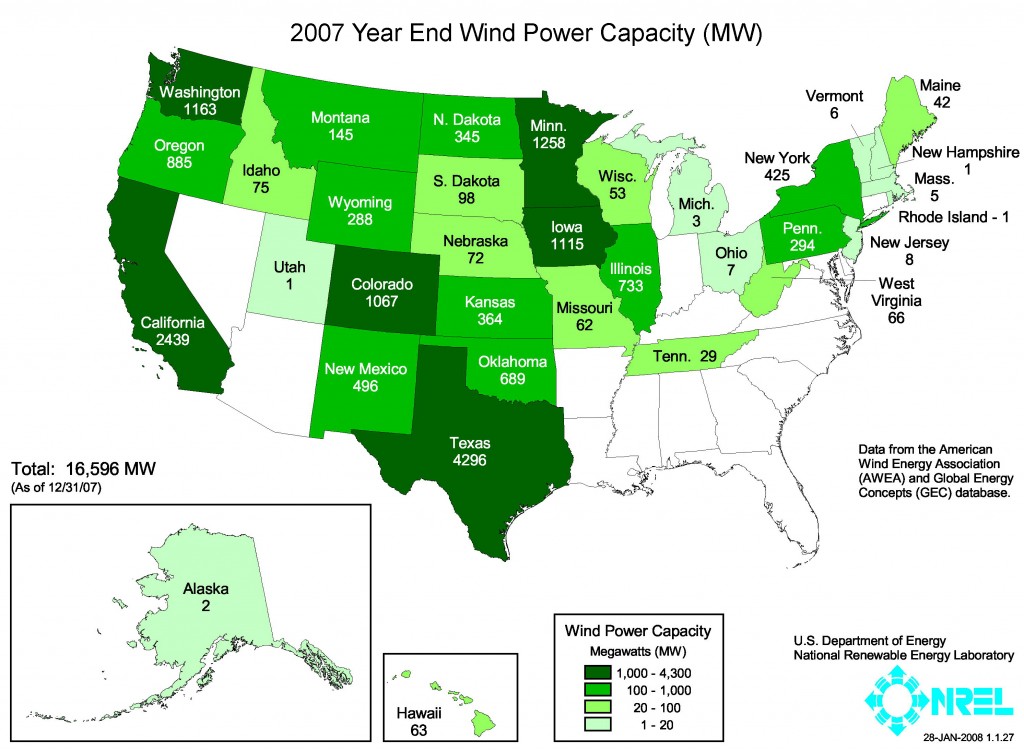
UNITED STATES WIND ENERGY SECTOR GROWTH 1981-2007
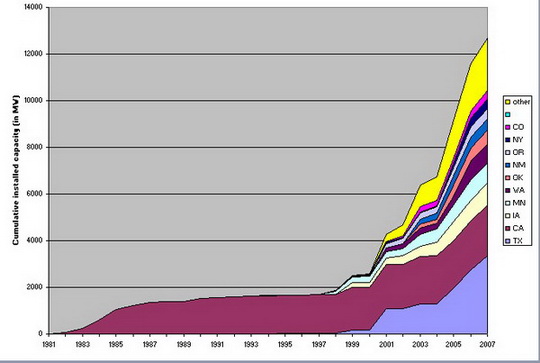
EUROPEAN WIND ENERGY STATISTICS (2007)

